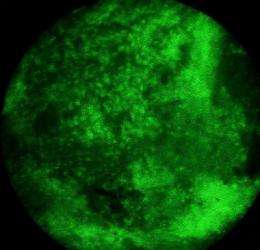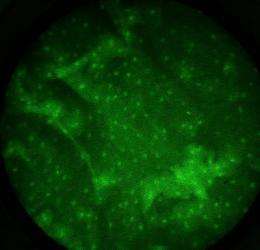Off-the-shelf cancer detection: Consumer-grade camera detects cancer cells in real time

Using an off-the-shelf digital camera, Rice University biomedical engineers and researchers from the University of Texas M.D. Anderson Cancer Center have created an inexpensive device that is powerful enough to let doctors easily distinguish cancerous cells from healthy cells simply by viewing the LCD monitor on the back of the camera.
The results of the first tests of the camera were published online this week in the open-access journal PLoS ONE.
"Consumer-grade cameras can serve as powerful platforms for diagnostic imaging," said Rice's Rebecca Richards-Kortum, the study's lead author. "Based on portability, performance and cost, you could make a case for using them both to lower health care costs in developed countries and to provide services that simply aren't available in resource-poor countries."
Richards-Kortum is Rice's Stanley C. Moore Professor of Bioengineering, professor of electrical and computer engineering and the founder of Rice's global health initiative, Rice 360°. Her Optical Spectroscopy and Imaging Laboratory specializes in tools for the early detection of cancer and other diseases. Her team has developed fluorescent dyes and targeted nanoparticles that let doctors zero in on the molecular hallmarks of cancer.
In the new study, the team captured images of cells with a small bundle of fiber-optic cables attached to a $400 Olympus E-330 camera. When imaging tissues, Richards-Kortum's team applied a common fluorescent dye that caused cell nuclei in the samples to glow brightly when lighted with the tip of the fiber-optic bundle. Three tissue types were tested: cancer cell cultures that were grown in a lab, tissue samples from newly resected tumors and healthy tissue viewed in the mouths of patients.
Because the nuclei of cancerous and precancerous cells are notably distorted from those of healthy cells, Richards-Kortum said, abnormal cells were easily identifiable, even on the camera's small LCD screen.

"The dyes and visual techniques that we used are the same sort that pathologists have used for many years to distinguish healthy cells from cancerous cells in biopsied tissue," said study co-author Mark Pierce, Rice faculty fellow in bioengineering. "But the tip of the imaging cable is small and rests lightly against the inside the cheek, so the procedure is considerably less painful than a biopsy and the results are available in seconds instead of days."
Richards-Kortum said software could be written that would allow medical professionals who are not pathologists to use the device to distinguish healthy from nonhealthy cells. The device could then be used for routine cancer screening and to help oncologists track how well patients were responding to treatment.
"A portable, battery-powered device like this could be particularly useful for global health," she said. "This could save many lives in countries where conventional diagnostic technology is simply too expensive."
Provided by Rice University
















